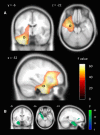The Neural Dynamics of Novel Scene Imagery
- PMID: 30902867
- PMCID: PMC6538850
- DOI: 10.1523/JNEUROSCI.2497-18.2019
The Neural Dynamics of Novel Scene Imagery
Abstract
Retrieval of long-term episodic memories is characterized by synchronized neural activity between hippocampus and ventromedial prefrontal cortex (vmPFC), with additional evidence that vmPFC activity leads that of the hippocampus. It has been proposed that the mental generation of scene imagery is a crucial component of episodic memory processing. If this is the case, then a comparable interaction between the two brain regions should exist during the construction of novel scene imagery. To address this question, we leveraged the high temporal resolution of MEG to investigate the construction of novel mental imagery. We tasked male and female humans with imagining scenes and single isolated objects in response to one-word cues. We performed source-level power, coherence, and causality analyses to characterize the underlying interregional interactions. Both scene and object imagination resulted in theta power changes in the anterior hippocampus. However, higher theta coherence was observed between the hippocampus and vmPFC in the scene compared with the object condition. This interregional theta coherence also predicted whether imagined scenes were subsequently remembered. Dynamic causal modeling of this interaction revealed that vmPFC drove activity in hippocampus during novel scene construction. Additionally, theta power changes in the vmPFC preceded those observed in the hippocampus. These results constitute the first evidence in humans that episodic memory retrieval and scene imagination rely on similar vmPFC-hippocampus neural dynamics. Furthermore, they provide support for theories emphasizing similarities between both cognitive processes and perspectives that propose the vmPFC guides the construction of context-relevant representations in the hippocampus.SIGNIFICANCE STATEMENT Episodic memory retrieval is characterized by a dialog between hippocampus and ventromedial prefrontal cortex (vmPFC). It has been proposed that the mental generation of scene imagery is a crucial component of episodic memory processing. An ensuing prediction would be of a comparable interaction between the two brain regions during the construction of novel scene imagery. Here, we leveraged the high temporal resolution of MEG and combined it with a scene imagination task. We found that a hippocampal-vmPFC dialog existed and that it took the form of vmPFC driving the hippocampus. We conclude that episodic memory and scene imagination share fundamental neural dynamics and the process of constructing vivid, spatially coherent, contextually appropriate scene imagery is strongly modulated by vmPFC.
Keywords: MEG; connectivity; hippocampus; scene construction; temporal dynamics; vmPFC.
Copyright © 2019 Barry et al.
Figures






References
Publication types
MeSH terms
Grants and funding
LinkOut - more resources
Full Text Sources
